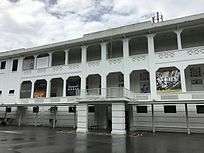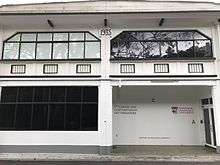Gillman Barracks
.jpg)
Gillman Barracks is a contemporary arts cluster in Singapore that is home to international art galleries, restaurants and the NTU Centre for Contemporary Art (CCA) Singapore, which are all housed in conserved colonial barracks. Gillman Barracks lies near to Alexandra Road, and the 6.4 hectare site covers Lock Road and Malan Road amid greenery. Gillman Barracks is jointly developed by the Singapore Economic Development Board, JTC Corporation and the National Arts Council.
History

Before Gillman Barracks was built in 1936, it was a land of mostly swamp and jungle. Named after the late General Sir Webb Gillman,[1] an esteemed officer sent by the British army,[2] Gillman Barracks was chosen to be the military barracks of the British due to its prime location near the sea. Gillman Barracks housed the 1st Battalion, Middlesex Regiment a line infantry regiment of the British Army, and the 2nd Battalion, Loyal Regiment of the British Army.[3] The plan was to accommodate the expansion of the British infantry in Singapore. The camp included married quarters for the officers, barracks buildings, sports facilities, messes, regimental institutes and even a swimming pool.
Gillman Barracks was one of the last British outposts to fall to the Japanese during the Second World War, where the Regiment fought the Japanese three days before Singapore fell in February 1942.[4] Upon Japanese surrender on 14 August 1945, command of the base transferred to the returning British forces.
In August 1971, the British handed over Gillman Barracks to the Singapore Armed Forces (SAF) for a token sum of $1, as part of their withdrawal from Singapore. For the next 13 years, it served as the headquarters for the School of Combat Engineering and the 3rd Transport Battalion. In the early 1970s, some of the buildings were also used by the Singapore American School for classroom space. In 1984, a similar handover was done between the School of Combat Engineering and the SAF Transport Base, with $1 being the handover fee.[5] Gillman Barracks was later vacated in 1990 and used subsequently for commercial purposes.[6]
After the SAF vacated the camp in the 1990s, the buildings were used for commercial purposes and the site was renamed Gillman Village in 1996. The main colonial building was repainted and renovated to include commercial spaces such as cafés, restaurants, bars and furniture shops.[7] The idea was to draw people to this slightly hidden enclave with the promise of colonial charm and delicious food and beverage options. However, Gillman Village was not very successful due to its isolated location and it had little human traffic.
In 2002, the Urban Redevelopment Authority (URA) declared Identity Plans for 15 areas in Singapore, with Gillman Village being one of that 15.[8] Grouped under the Southern Ridges and Hillside Villages category, the plan was to "enhance (the) activities" within this area through the introduction of "new buildings" and the act of "bringing in more activities". The Identity Plans were met with strong public support, as shown by surveys done at the URA centre from 23 July to 23 October 2002. 72% of respondents agreed with the proposed enhancements.[9]
In 2010,[10] the Singapore government announced plans to redevelop Gillman Village, reverting to its original name, Gillman Barracks. Gillman Barracks was launched in September 2012 as a contemporary art centre with 13 art galleries joining its ranks, including well-established galleries such as Tomio Koyama Gallery and Sundaram Tangore Gallery.[11] The area is now a site for arts-related activities, where various agencies like the Economic Development Board (Development and Promotion), JTC Corporation (Refurbishment and Construction) and National Arts Council (Promotion of Singapore Arts Scene) work together to develop this area.[12]
In April 2015, five galleries—almost a third of the 17 galleries there—did not renew their leases, citing low human traffic, poor sales and a slow start to the arts enclave. This came after "three years of persistently low footfall".[13]
In February 2016, Galerie Michael Janssen also left, citing how they "felt the project has not taken off as envisioned". Singapore design label Supermama, ice cream shop Creamier and Australian gallery Sullivan+Strumpf moved in instead.[14]
Buildings
Block 9

Known as the primary colonial building, it once housed some of the British Army’s most well-known warrant officers, such as General Sir Webb Gillman himself.[15] This building served as the officers’ married quarters, with recreational activities such as badminton carried out in the open spaces in front of the building. Today, the main colonial building has been named Block 9 in Gillman Barracks, the main and biggest block in the contemporary arts cluster. The similar colonial architecture has been preserved, and has survived various transformations in the Gillman area. Similar big windows, wide corridors and high arches are still present, allowing for good ventilation within the building.
The Army Kinema Corporation (AKC)

After the Second World War, the British War Office in London established the Army Kinema Corporation and set up the Regal Cinema at Gillman Barracks to entertain the British troops stationed there. Movies were screened twice nightly except Tuesday nights, ranging from films such as Ben Hur (1959) and Jailhouse Rock (1957). During the time of Gillman Village, the same building was preserved, but served a different purpose. It was known as the Verve Bar & Bistro. The AKC (Army Kinima Corporation) logo remained on the side of the building, and was repainted. After the redevelopment of Gillman Village into Gillman Barracks, the building serves commercial art galleries and exhibitions, while still preserving its famous AKC logo at the exterior of the building. It is also known as Block 7 today, the only block with a pointed roof within Gillman Barracks.
Bourne School

From 1945 onwards, the British Forces Schools once operated within the Army and Naval Bases in Singapore.[16] Alexandra Grammar School was built on top of the hill at Gillman Barracks, and later renamed Bourne Secondary School in 1964. Students would take the side steps up to Bourne School at the top of hill. The school has since relocated to Preston Road, and is now known as the ISS International School – not too far from where Gillman Barracks is. Today, the similar side steps which used to lead up to the school are covered up by grown trees and vegetation, with art fixtures near Block 37.
Vision
In its conception, the Gillman Barracks aims to foster cultural exchange and creation, generating discourse and research and showcasing innovative art. The galleries, education and outreach efforts are to establish Singapore as an important centre for contemporary art in Asia.
The art cluster is an effort to create vibrant arts scene in Singapore made up of public museums, commercial galleries, non-profit spaces, and major art events such as the Singapore Biennale and Art Stage Singapore.[17] The vision promotes Gillman Barracks as a contemporary arts space – to display and sell art – while preserving part of the area’s colonial history. Today, various colonial barracks, including Block 9, are home to art galleries, shops and restaurants.
Galleries

The galleries feature diverse exhibitions from internationally acclaimed artists, of Southeast Asia and around the world. Artists include both the established and emerging such as Alfredo and Isabel Aquilizan, Heman Chong, Ai Weiwei, Yayoi Kusama, Yoshitomo Nara and Sebastião Salgado.[17] Tours are also provided by Friends of the Museums, giving the public insight to the art located within the Barracks, as well as the Barracks' rich history and heritage.[18][19][20]
Education and outreach
Gillman Barracks is also home to several art institutions and charities, including:
- Nanyang Technological University Centre for Contemporary Arts - devoted to advancing knowledge in contemporary art through its international artist residencies, research and exhibition programmes that will bolster the region’s visual arts landscape.[21]
- Art Outreach - a non-profit art education organisation that promotes art appreciation in Singapore started in 2003. The programme exposes participants to the world of art and promotes visual literacy.
See also
| Wikimedia Commons has media related to Gillman Barracks. |
References
- ↑ "NEW BARRACKS FOR SINGAPORE". The Straits Times. 3 June 1935. p. 7. Retrieved 22 November 2015 – via NewspaperSG.
- ↑ Sir Webb Gillman [Obituary]. (1933, April 21). The Times. Retrieved November 26, 2008, from The Times Digital Archive.
- ↑ "NLB Infopedia".
- ↑ "Gillman Barracks Factsheet" (PDF).
- ↑ "NewspaperSG - Terms and Conditions". Retrieved 2017-03-03.
- ↑ "EDB Singapore Media Release: Gillman Barracks Art Galleries to Open September 15" (PDF).
- ↑ "Where History and Art Meet - Gillman Barracks".
- ↑ "URA launches Identity Plans for 15 areas in Singapore". www.ura.gov.sg. Retrieved 2017-03-03.
- ↑ "URA's Parks & Waterbodies and Identity Plans receive strong public support". www.ura.gov.sg. Retrieved 2017-03-03.
- ↑ Singapore Economic Development Board. (2011). Singapore Economic Development Board calls for Expressions of Interests (EOI) for galleries to set up in Gillman Barracks extended to 26 August 2011 [Press release]. Retrieved October 25, 2011, from http://www.edb.gov.sg/edb/sg/en_uk/index/news/articles/sedb_calls_for_expressions_of_interest_for_galleries_to_set_up_in_gillman_barracks.html
- ↑ Poon, C. H. (2011, June 19). Home for art galleries at Gillman Barracks. The Straits Times. Retrieved October 25, 2011, from Factiva.
- ↑ "New life for old barracks".
- ↑ Shetty, Deepkia (11 April 2015). "Nearly a third of Gillman Barracks galleries have decided not to renew their leases". Singapore Press Holdings. The Straits Times. Retrieved 9 April 2016.
- ↑ Shetty, Deepkia (2 February 2016). "Home-grown brands Supermama and Creamier open at Gillman Barracks". Singapore Press Holdings. The Straits Times. Retrieved 9 April 2016.
- ↑ "Building secrets: Gillman Barracks".
- ↑ "The Lost Soul of Bourne School".
- 1 2 "About Gillman Barracks". Gillman Barracks. Archived from the original on 2015-09-06. Retrieved 2015-09-08.
- ↑ "Gillman Barracks Tours". Gillman Barracks. Retrieved 2015-09-08.
- ↑ "Gillman Barracks Galleries". Gillman Barracks. Retrieved 2015-09-08.
- ↑ https://www.gillmanbarracks.com/art-galleries
- ↑ "School of Art, Design and Media: NTU Centre for Contemporary Art Singapore". NTU School of Art, Design and Media. Nanyang Technological University.